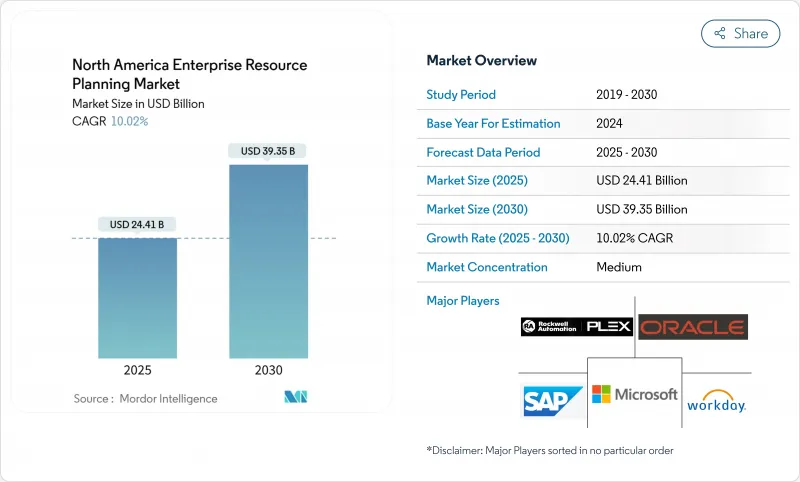
|
市場調査レポート
商品コード
1849892
北米の企業資源計画:市場シェア分析、産業動向、統計、成長予測(2025年~2030年)North America Enterprise Resource Planning - Market Share Analysis, Industry Trends & Statistics, Growth Forecasts (2025 - 2030) |
||||||
カスタマイズ可能
適宜更新あり
|
|||||||
| 北米の企業資源計画:市場シェア分析、産業動向、統計、成長予測(2025年~2030年) |
|
出版日: 2025年06月30日
発行: Mordor Intelligence
ページ情報: 英文 120 Pages
納期: 2~3営業日
|
概要
北米の企業資源計画市場規模は2025年に244億1,000万米ドル、2030年には393億5,000万米ドルに達すると予測され、CAGRは10.0%と堅調に推移しています。

この拡大は、レガシーなオンプレミス・スイートから、企業に俊敏性、リアルタイムの洞察、消費ベースのコスト構造を提供するクラウド・ネイティブ・プラットフォームへの地域全体の移行を反映しています。また、環境・社会・ガバナンス(ESG)の開示が義務化されたことで、企業は財務連結プロセスの近代化を迫られています。オラクルは2024年に売上高87億米ドル、市場シェア6.63%(北米の企業資源計画)でSAPを抜いて地域最大のERPアプリケーション・サプライヤーとなり、ティア1ベンダー間のライバル関係の激化を浮き彫りにしています。米国は州や地方のシステムの近代化を続けており、カナダのデジタル導入プログラムは製造業のERP投資を助成し、メキシコはUSMCAのデジタル貿易条項を活用して国境を越えたデータの流れを合理化しています。
北米の企業資源計画市場動向と洞察
クラウドファーストのERP導入モデルへの急速なシフト
コスト、拡張性、リモートワークのサポートがオンプレミス志向を駆逐し、クラウド導入がERP新規導入の基本となっています。ワシントン州クラーク郡では、Workdayへの移行後、給与計算が60%高速化し、未承認支出が15%削減されました。ハイブリッドアーキテクチャが依然として一般的なのは、規制の厳しい企業が機密データをオンプレミスに保持する一方で、エッジ機能や特殊機能をパブリッククラウドで拡張しているためです。製造業ではセキュリティへの投資が急増し、財務チームはサブスクリプション・プライシングによって、ハードウェアの更新サイクルよりも戦略的イノベーションに資本予算を振り向けることができるようになりました。最高情報責任者(CIO)は、テクノロジーのアップグレードと並行して、関係者のトレーニングを優先し、文化的な採用とアーキテクチャの変革を一致させる。
リアルタイム意思決定のためのAI組み込みアナリティクスの急増
生成モデルと予測モデルは、ERPをトランザクションレコーダーからインテリジェントなオーケストレーションエンジンへと再形成しています。IBMとオラクルは現在、財務、サプライチェーン、人事のワークフロー全体でポリシーに準拠したアクションを推奨する自律エージェントを共同開発しています。NetSuiteの機械学習による買掛金モジュールは、手作業による請求書入力を減らし、照合を迅速化することで、月末の締めを緩和します。製造業は、工場レベルのモジュールにAIを組み込んで予知保全を行い、すでにスマートファクトリー技術を導入している95%の企業で、計画外のダウンタイムの短縮を推進しています。ヘルスケアプロバイダーは、アナリティクスを活用して臨床データと財務データを照合し、診療報酬の精度とコンプライアンス報告を改善します。アルゴリズムの偏りやデータの陳腐化は、自動化された意思決定に対する信頼を損ないかねないため、すべてのイニシアチブは強固なガバナンスに依存しています。
導入と変更管理の先行コストとライフサイクルコスト
包括的なERPプロジェクトでは、ライセンス料やサブスクリプション料だけでなく、さまざまな費用が発生します。バプティスト・ヘルスの複数年にわたる近代化に見られるように、データの移行、ビジネスプロセスのリエンジニアリング、スタッフのトレーニングは、病院や公的機関にとって当初の予算の2倍になることがよくあります。中小企業では、専任のITキャパシティが不足しているため、外部のコンサルタントに頼っていますが、人材が不足しているため、日当が高くなり、スケジュールが延び延びになっています。クラウドデリバリーは資本支出を抑えるが、プロセスの標準化に必要な文化的シフトを排除することはできないです。強固なチェンジ・リーダーシップ構造がなければ、高価なプラットフォームが十分に活用されず、ROIが低下するリスクがあります。
セグメント分析
2024年の売上はクラウドネイティブスイートが60.5%を占め、北米の企業資源計画市場は広範な機能を持つプラットフォームの強力なベースラインを維持しています。しかし、ソーシャル/コラボレーション型ERPは、企業がコンシューマーグレードのユーザーエクスペリエンスを求めるにつれて、2030年までのCAGRが11.4%と最も急速に成長します。ナレッジワーカーは、財務やサプライチェーンのトランザクション内で、アクティビティフィード、共有ダッシュボード、リアルタイムチャットを採用し、システム利用率を高め、承認サイクルを短縮します。統合されたモバイルアプリは、現場や顧客先でも同じ機能を提供し、常時接続のワークフローを強化します。ベンダーのロードマップは、ソーシャル要素をオプションのモジュールとしてではなく、デフォルトでバンドルするようになってきており、その戦略的価値を強調しています。やがて、これらのチャネルに組み込まれた人工知能アシスタントが行動を推奨したり、例外にフラグを立てたりするようになり、エンゲージメントと業務効率の結びつきが深まる。
財務・会計は、報告や監査の必須要件を反映して、2024年の北米の企業資源計画市場規模の55.7%を維持します。それにもかかわらず、サプライチェーンとオペレーションのモジュールはCAGR 10.8%で拡大します。エッジコンピューティングとモノのインターネットは、リアルタイムの現場データを計画アルゴリズムに送り込み、資材の供給能力を向上させ、運転資本を削減します。出荷予測ETAはオムニチャネルのコミットメントをサポートし、自動化された品質チェックは返品率を削減します。一方、労働力不足や離職率の上昇に直面する製造業では、人的資本モジュールが優先されます。カスタマー・コマース・アドオンは、注文の取り込みと在庫を結びつけ、コンバージョン率を高める正確な納期を約束できるようにします。財務は依然としてシステム・オブ・レコードとして機能しているが、業務データセットが損益の結果を左右することが多くなっています。
その他の特典:
- エクセル形式の市場予測(ME)シート
- 3ヶ月間のアナリストサポート
よくあるご質問
目次
第1章 イントロダクション
- 調査の前提条件と市場の定義
- 調査範囲
第2章 調査手法
第3章 エグゼクティブサマリー
第4章 市場情勢
- 市場概要
- 市場促進要因
- クラウドファーストのERP導入モデルへの急速な移行
- リアルタイムの意思決定のためのAI組み込み分析の急増
- 本社と子会社の業務を調和させるための2層ERP導入
- 手頃な価格のモジュール型SaaSスイートに対する中小企業の需要の高まり
- ESG関連の報告義務によりシステムのアップグレードが加速
- クローズドループ運用のためのエッジ/IoTデータ統合
- 市場抑制要因
- 実装と変更管理の初期費用とライフサイクルコスト
- マルチテナントクラウドにおけるサイバーセキュリティとデータ主権の懸念
- 北米を拠点とするERP人材とプロジェクト能力の不足
- オンプレミスのサポート期間が短縮される中でベンダーロックインのリスクが高まる
- バリューチェーン分析
- 規制情勢
- テクノロジーの展望
- ポーターのファイブフォース分析
- 供給企業の交渉力
- 買い手の交渉力
- 新規参入業者の脅威
- 代替品の脅威
- 競争企業間の敵対関係
- マクロ経済動向の市場への影響評価
第5章 市場規模と成長予測
- タイプ別
- クラウドネイティブスイート
- モバイルファーストERP
- ソーシャル/コラボレーションERP
- 2層/エッジERP
- 業務機能別
- 財務と会計
- サプライチェーンとオペレーション
- 人材管理
- 顧客関係と商取引
- 製造実行と品質
- 展開モデル別
- オンプレミス
- クラウド
- 組織規模別
- 大企業
- 中小企業
- 業界別
- 製造業
- 小売業とeコマース
- BFSI
- 政府および公共部門
- ITおよび通信
- ヘルスケアとライフサイエンス
- その他
- 国別
- 米国
- カナダ
- メキシコ
第6章 競合情勢
- 市場集中度
- 戦略的動向
- 市場シェア分析
- 企業プロファイル
- SAP SE
- Oracle Corporation
- Microsoft Corporation
- Workday Inc.
- Infor Inc.
- Epicor Software Corporation
- IBM Corporation
- The Sage Group plc
- Plex Systems Inc.(Rockwell Automation)
- FinancialForce.com Inc.
- Unit4 NV
- Deltek Inc.
- Deacom Inc.
- Acumatica Inc.
- IFS AB
- Syspro USA Inc.
- QAD Inc.
- Oracle NetSuite
- SAP Business One
- Odoo SA


